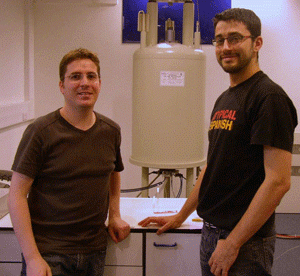
Effects of PI 3-kinase and mTOR inhibitors on treating spontaneous treating B-cell follicular lymphoma revealed
The PI 3-kinase-mTOR signalling pathway is activated in the majority of human tumours and there is great interest in assessing whether inhibitors of PI 3-kinase or mTOR kinase would have efficacy in treating cancers in which this pathway is over activated.
Stephan Wullschleger and Juan M. GarcÃÂ_a-MartÃÂ_nez, MRC Unit postdocs were interested to answer the question of whether state-of-the-art PI 3-kinase and mTOR inhibitors would be effective at treating tumours that arise spontaneously in mouse model of cancer. These model being more representative of human tumours than Xenograft models frequently employed to assess the effectiveness of potential anti-cancer drugs.
To tackle this question Stephan and Juanma teamed up with Suzanne Duce an MRI expert at the Division of Biological Chemistry & Drug Discovery, College of Life Sciences in Dundee.
Stephan and Juanma decided to make use of a strain of mouse (PTEN+/-LKB1+/hypo) in which the PI 3-kinase/mTOR pathway is activated and spontaneously develop B-cell follicular lymphomas about 6 months of age.
They waited until substantial tumours had formed and then commenced treatment with either a compound called GDC-0941 (a Genentech PI 3-kinase inhibitor) or a compound termed AZD8055 (an AstraZeneca mTOR inhibitor) that are both in clinical trials.
Using MRI methodology, Suzanne was able to demonstrate that administration of either AZD8055 or GDC-0941 induced ~40% reduction in tumour volume within 2 weeks. Signalling experiments showed that this reduction in tumour volume was accompanied by ablation of phosphorylation of PI 3-kinase-mTOR pathway substrates (AKT, S6K and SGK).
The drugs also reduced tumour cell proliferation and promoted apoptosis, which resulted in reduction of the centroblast population within the tumours. Further treatment with either AZD8055 or GDC-0941 beyond two weeks caused a moderate additional decrease in tumour volume, reaching ~50% of the initial volume after 6 weeks of treatment. Upon cessation of drug treatment, tumours grew back at a slightly increased rate compared to aged-matched non-drug treated tumours, and displayed similar high grade and diffuse morphology as the controls.
These results define the effects that newly designed and highly specific mTOR and PI3K inhibitors have on a spontaneous tumour model. These data suggest that AZD8055 and GDC-0941 would offer benefit for the treatment of cancers in which the PI 3-kinase-mTOR pathway is inappropriately activated; however, other combination strategies would need to be tested to induce the complete regression of such tumours.
We propose that the spontaneous cancer model elaborated in this work could be utilised to benchmark the relative effectiveness of PI3K/mTOR inhibitors at suppressing tumour growth. It would be interesting to test whether it was possible to develop signal transduction inhibitors that were more effective than GDC-0941 or AZD8055 at reducing tumour burden as single agents.
To read a copy of Stephan's, Juanma's and Suzanne's paper click here
Stephan Wullschleger and Juan M. GarcÃÂ_a-MartÃÂ_nez, MRC Unit postdocs were interested to answer the question of whether state-of-the-art PI 3-kinase and mTOR inhibitors would be effective at treating tumours that arise spontaneously in mouse model of cancer. These model being more representative of human tumours than Xenograft models frequently employed to assess the effectiveness of potential anti-cancer drugs.
To tackle this question Stephan and Juanma teamed up with Suzanne Duce an MRI expert at the Division of Biological Chemistry & Drug Discovery, College of Life Sciences in Dundee.
Stephan and Juanma decided to make use of a strain of mouse (PTEN+/-LKB1+/hypo) in which the PI 3-kinase/mTOR pathway is activated and spontaneously develop B-cell follicular lymphomas about 6 months of age.
They waited until substantial tumours had formed and then commenced treatment with either a compound called GDC-0941 (a Genentech PI 3-kinase inhibitor) or a compound termed AZD8055 (an AstraZeneca mTOR inhibitor) that are both in clinical trials.
Using MRI methodology, Suzanne was able to demonstrate that administration of either AZD8055 or GDC-0941 induced ~40% reduction in tumour volume within 2 weeks. Signalling experiments showed that this reduction in tumour volume was accompanied by ablation of phosphorylation of PI 3-kinase-mTOR pathway substrates (AKT, S6K and SGK).
The drugs also reduced tumour cell proliferation and promoted apoptosis, which resulted in reduction of the centroblast population within the tumours. Further treatment with either AZD8055 or GDC-0941 beyond two weeks caused a moderate additional decrease in tumour volume, reaching ~50% of the initial volume after 6 weeks of treatment. Upon cessation of drug treatment, tumours grew back at a slightly increased rate compared to aged-matched non-drug treated tumours, and displayed similar high grade and diffuse morphology as the controls.
These results define the effects that newly designed and highly specific mTOR and PI3K inhibitors have on a spontaneous tumour model. These data suggest that AZD8055 and GDC-0941 would offer benefit for the treatment of cancers in which the PI 3-kinase-mTOR pathway is inappropriately activated; however, other combination strategies would need to be tested to induce the complete regression of such tumours.
We propose that the spontaneous cancer model elaborated in this work could be utilised to benchmark the relative effectiveness of PI3K/mTOR inhibitors at suppressing tumour growth. It would be interesting to test whether it was possible to develop signal transduction inhibitors that were more effective than GDC-0941 or AZD8055 at reducing tumour burden as single agents.
To read a copy of Stephan's, Juanma's and Suzanne's paper click here

